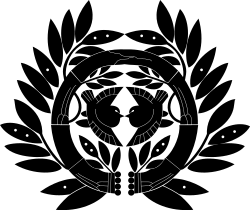Kameoka Hachimangū
| Kameoka Hachimangū 亀岡八幡宮 | |
|---|---|
 Crest of the Date clan | |
| Basic information | |
| Location | 62 Kawauchi, Kameoka-chō Aoba-ku, Sendai, Miyagi |
| Affiliation | Shinto |
| Deity | Hachiman |
| Leadership | Kōriyama Munekatsu |
| Website |
www |
| Architectural description | |
| Founder | Date Tomomune |
| Date established | 1190, moved to present site 1681, rebuilt October 1965. |
|
| |
Kameoka Hachimangū (亀岡八幡宮) is a Shinto shrine in Aoba-ku, Sendai, Miyagi, Japan. It is the tutelary shrine of the Date clan.
History
Kameoka Hachimangū was founded in 1190 as a branch of Tsurugaoka Hachimangū by Date Tomomune, the Date clan founder, at Yanagawa in modern Fukushima Prefecture.[1] The 1719 text Ōū Kanseki Monrōshi , however, claims that the shrine was founded by Tomomune's son Munemura.[2] A legend in the Date clan holds that a mythical black turtle, one of the four benevolent animals, appeared as the shrine was under construction, thus prompting its name of Kameoka ("Turtle Hill") Hachimangū.[3] There is a smaller, subsidiary shrine, Kōratamatare-jinja, which stands beside the sanctuary.
Moved several times in its history, it has been at its present location in Sendai's Aoba Ward, northwest of Aoba Castle, since 1681.[2] Its move to its present location was by order of Date Tsunamura.[3]
Haiku poets Matsuo Bashō and Kawai Sora visited the shrine in 1689 during the trip described in the book Oku no Hosomichi.[1]
During the Edo period and the existence of Sendai domain, the shrine's neighborhood and its residents had privileged status. Their affairs came under the jurisdiction of the Date clan's Temple and Shrine Magistrates rather than the clan's Sendai City Magistrates who usually oversaw municipal affairs. The shrine neighborhood's residents also had the right to brew vinegar; other shrine neighborhoods, such as that around Sendai Tōshōgū, were allowed to brew sake.[4]
The shrine was destroyed in July 1945 during the Bombing of Sendai during World War II, with only the stone torii and a few other stone structures surviving. The shrine was rebuilt in October 1965.[3] Its present chief priest is Kōriyama Munekatsu.[5] One of the shrine's treasures, a sword made by Osafune Yoshimitsu, is listed as an Important Cultural Property by the Japanese government.[3]
In popular culture
Kameoka Hachimangū, under its brief Muromachi era alternate name of Yanagawa Hachimangū, appears as a setting in the GAINAX-produced anime Masamune Datenikuru.[6] The deity Hachiman holds as collateral the soul of young Date Masamune, in a bid to prompt him toward courage and responsibility as the new Date lord.
References
- 1 2 ""由緒"". Hachimanguu.org. Retrieved 3 November 2017.
- 1 2 Anonymous (1994). Ōū Kanseki Monrōshi, in Shintō Taikei v. 27. Shintō Taikei Hensankai. p. 97.
- 1 2 3 4 "Kameoka Hachimangū," on Miyagi Shrine Office's website, accessed 3 Nov. 2017
- ↑ Mihara Ryōkichi (1983). Kyōdoshi Sendai Mimibukuro. Hōbundō. pp. 123–127.
- ↑ ""挨拶"". Hachimanguu.org. Retrieved 3 November 2017.
- ↑ "Masamune Datenikuru official Youtube presence". GAINAX. Retrieved 3 November 2017.
External links
Coordinates: 38°15′42″N 140°50′35″E / 38.2616°N 140.8431°E